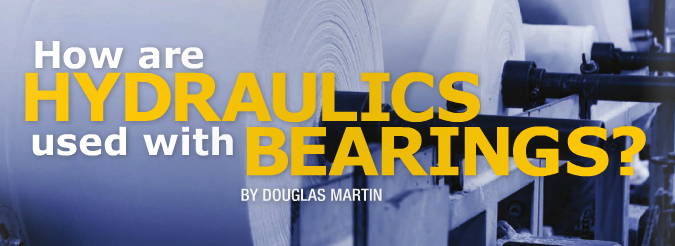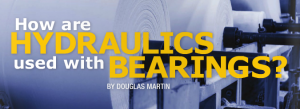
What’s Up Doug? How are hydraulics used with bearings?
September 9, 2016 | By Douglas Martin

 Bearings are precision components that need to be handled with care during installation or removal (mounting and dismounting). The method of using hydraulics with bearings for installation and removal is applied only when provided for in the design of the mounting. There are two main processes that can be used:
Bearings are precision components that need to be handled with care during installation or removal (mounting and dismounting). The method of using hydraulics with bearings for installation and removal is applied only when provided for in the design of the mounting. There are two main processes that can be used:
- – Apply force on the ring that needs to be moved
- – Create a “cushion” or film to overcome the friction force to move the bearing
Applying the force to the inner ring
The tool used to apply the force to the bearing is called a hydraulic nut. It is essentially an annular piston, typically with threads on its bore that allow it to be fixed to the shaft or sleeve to anchor it when applying pressure to the bearing inner ring. Hydraulic nuts are only used when the application requires an interference fit with the inner ring (including driving the bearing up a taper, which in truth creates the interference fit).
Some hydraulic nuts have no threads on the bore. In this case, the nut is anchored to the shaft by using an end plate on the shaft for the body of the hydraulic nut to push against.
Conceivably, a specially designed hydraulic nut could be made to push the outer ring of a bearing into its tight-fitted housing. Since a tight-fitted outer ring is relatively uncommon, there are no standard hydraulic nuts designed for this, however the principal remains the same. The body of the hydraulic nut would be fixed to the housing and the piston would apply force to the outer ring.
Creating a Cushion
A hydraulic oil film applied between the bearing and its seat reduces the frictional sliding force and allows easy installation or removal of the bearing. In reality, the hydraulic film plays a dual role. It creates an oil film and it stretches (compresses) the ring. In both cases, the amount of force required to install or remove the bearing is reduced.
To apply this force, a channel needs to be drilled through the shaft (or housing) that intersects with a radial channel that feeds a circumferential groove on the bearing seat. This must be done when the shaft or housing is first manufactured or reworked. It cannot be done as an afterthought or at the time of mounting or dismounting.
When it comes time to install or dismount, the hydraulic pressure is applied between the ring and seat and then the bearing is pushed or pulled on or off the shaft/housing using some other method of force like a press or puller.
Combination
Some assemblies will have both features, a hydraulic nut to apply the installation pressure and a hydraulic shaft or housing feature to reduce the force to install.
What’s the benefit?
By using hydraulics to install or remove bearings, there is significant savings on a number of fronts – time taken, safety and not damaging the bearing or surrounding components. To be simple, when installing you are avoiding the bashing of a locknut with a hammer and drift, and when removing you are avoiding the use of a torch or zip cutter, which avoids fire risk (as well as avoids additional work permits).
So why don’t all bearing applications come predesigned with hydraulic install and removal features? The problem is where the cost is assigned. Shafts and housings with the hydraulic design features would have to come from the original equipment manufacturer with the hydraulic features. The original equipment is purchased with a capital budget, but the savings come into the maintenance and/or operations budgets that are not often influential in the capital purchase decision (or initial specification).
There are some industries in which hydraulic features are “standard.” The most notable is the paper industry, where is it is used in the paper machine rolls. Since the bearings used on paper machine rolls are large, expensive and are regularly changed (for roll re-surfacing operations), the ability to efficiently install and remove bearings are critical to efficient operations.
Douglas Martin is a heavy-duty machinery engineer based in Vancouver. He specializes in the design of rotating equipment, failure analysis and lubrication. Reach him by email at mro.whats.up.doug@gmail.com.
